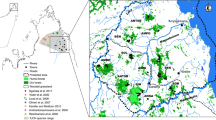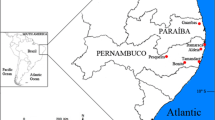Abstract
Tropical dry forests are biologically important biomes sustaining a high rate of endemic species. However, these forests are highly threatened by human activities that negatively impact them on distinct levels, including the genetic diversity. Within the framework of landscape genetics (that seeks to evaluate the relation of characteristics of the environmental matrix with population genetics), we used ISSR markers to evaluate the relationship between the alteration of tropical dry forest by human-induced activities (conserved vs. disturbed) with the genetic structure of four breeding sites of the southern pygmy mouse Baiomys musculus. Averaging among the 105 loci used, the unbiased heterozygosis per population (0.247–0.305) was statistically similar among the four sites, as well as between conserved and disturbed conditions (2-way ANOVA F (3,16) = 1.47, P = 0.1984). The genetic differentiation among the four breeding sites was high (F ST = 0.1122; 95 % CI 0.082–0.146) considering the geographical scale evaluated (ca. 4 km). Both, a factorial correspondence analysis and a model-based clustering analysis showed the existence of four genetic groups (one per breeding site). However, no association of genetic structure with disturbance conditions was revealed by these analyses. The absence of differences in mean genetic diversity and the lack of association of genetic structure with habitat transformation suggest that B. musculus has enough behavioral plasticity and enough genetic diversity to respond to environmental heterogeneity caused by human activities. We discussed conditions in which habitat transformation could indeed favor B. musculus.



Similar content being viewed by others
References
Álvarez-Castañeda ST (1996) Los mamíferos de Morelos. CIBNOR, La Paz
Amman BR, Bradley RD (2004) Molecular evolution in Baiomys (Rodentia: Sigmodontimae): evidence for a genetic subdivision in B. musculus. J Mammal 85:162–166
Belkhir K, Borsa P, Chikhi L, Raufaste N, Bonhomme F (1996–2004) GENETIX 4.05. Population genetics software for Windows TM. Laboratoire Génome, Populations, Interactions, CNRS UMR 5000, Université de Montpellier II, Montpellier, France
Bogdanov S, Atopkin DM, Chelomina GN (2009) Analysis of genetic variation and differentiation in the pygmy wood mouse Sylvaemus uralensis (Rodentia, Muridae) aided by the RAPD-PCR method. Biol Bull 36:227–241
Bowman J, Forbes G, Dilworth T (2000) The spatial scale of variability in small-mammal populations. Ecography 23:328–334
Busch JD, Waser PM, DeWoody JA (2009) The influence of density and sex on patterns of fine scale genetic structure. Evolution 63:2302–2314
Cadena M (2003) Efectos de la perturbación y estacionalidad en la comunidad de roedores en una selva baja caducifolia en Morelos. Tesis profesional, Universidad de las Américas, México
Ceballos G, Miranda A (2000) A field guide to the mammals of the Jalisco coast, México. Fundación Ecológica de Cuixmala, A. C. and Universidad Nacional Autónoma de México, México
Ceballos G, Oliva G (2005) Los mamíferos silvestres de México. Fondo de Cultura Económica/CONABIO, México
CONANP (2005) Programa de conservación y manejo Reserva de la Biosfera Sierra de Huautla. Comisión Nacional de Áreas Naturales Protegidas, México
Cooper ML (2000) Random amplified polymorphic DNA analysis of southern brown bandicoot (Isoodon obesulus) populations in Western Australia reveals genetic differentiation related to environmental variables. Mol Ecol 9:469–479
Cushman SA (2006) Effects of habitat loss and fragmentation on amphibians: a review and prospectus. Biol Conserv 128:231–240
De la O-Toris J (2009) Efecto de la ganadería extensiva en el estrato herbáceo de la selva baja caducifolia en El Limón de Cuauchichinola, Sierra de Huautla, Morelos. Tesis profesional, Universidad Autónoma del Estado de Morelos, México
Evanno G, Regnaut S, Goudet J (2005) Detecting the number of clusters of individuals using the software structure: a simulation study. Mol Ecol 14:2611–2620
Fetzner JJ (1999) Extracting high-quality DNA from shed reptile skins: a simplified method. Biotechniques 26:1052–1054
Frankham R (1996) Correlation of genetic variation to population size in wildlife. Conserv Biol 10:1500–1508
Gannon WL, Sikes RS (2007) Guidelines of the American Society of Mammalogists for the use of wild mammals in research. J Mammal 88:809–823
García-Estrada C, Romero-Almaráz ML, Sánchez-Hernández C (2002) Comparison of rodent communities in sites with differents degrees of disturbance in deciduous forest of southeastern Morelos, Mexico. Acta Zool Mex 85:153–168
Gauffre B, Estoup A, Bretagnolle V, Cosson JF (2008) Spatial genetic structure of a small rodent in a heterogeneous landscape. Mol Ecol 17:4619–4629
Gerlach G, Musolf K (2000) Fragmentation of landscape as a cause of genetic subdivision of bank voles. Conserv Biol 14:1066–1074
Johansson M, Primmer CR, Merila J (2007) Does habitat fragmentation reduce fitness and adaptability? A case study of the common frog (Rana temporaria). Mol Ecol 16:2693–2700
Koenig WD, Vuren DV, Hooge PN (1996) Detectability, phylopatry, and the distribution of dispersal distances in vertebrates. Trends Ecol Evol 11:514–517
Lynch M, Milligan BG (1994) Analysis of population genetic structure with RAPD markers. Mol Ecol 3:91–99
Maass M, Búrquez A, Trejo I, Valenzuela D, González MA, Rodríguez M, Arias H (2010) Amenazas. In: Ceballos G, Martínez L, García A, Espinoza E, Bezaury J, Dirzo R (eds) Diversidad, amenazas y regiones prioritarias para la conservación de las selvas secas del Pacífico de México. FCE, CONABIO, CONANP, WWF, Ecociencia SC, Telmex, México, pp 321–346
Manel S, Schwartz MK, Luikart G, Taberlet P (2003) Landscape genetics: combining landscape ecology and population genetics. Trends Ecol Evol 18:189–197
Mason E (2005) Efecto de la perturbación del hábitat y la estacionalidad climática en la dieta de Liomys irroratus (Gray, 1868) en una selva seca del sur del estado de Morelos. Tesis profesional, Universidad Autónoma del Estado de Morelos, México
Merriam CH (1892) Descriptions of new mammals collected by E. W. Nelson in the state of Colima and Jalisco, Mexico. Proc Biol Soc Wash 7:164–174
Miles L, Newton AC, DeFries RS, Ravilious C, May I, Blyth S, Kapos V, Gordon JE (2006) A global overview of the conservation status of tropical dry forests. J Biogeogr 33:491–505
Miller MA (1997) Tools for population genetics analysis TFPGA Version 1.3. Departament of Biological Science. Northern Arizona University, Flagstaff, AZ
Miranda A (1997) Deforestación y fragmentación del hábitat: consecuencias ecológicas sobre la fauna de mamíferos de la selva tropical estacional. Universidad Nacional Autónoma de México. Instituto de Ecología. Informe final SNIB-CONABIO proyecto No. B033, México
Nei M (1978) The theory of genetic distance and evolution of human races. Jpn J Hum Genet 23:341–369
Ortega-Huerta MA (2007) Fragmentation patterns and implications for biodiversity conservation in three biosphere reserves and surrounding regional environments, northeastern Mexico. Biol Conserv 134:83–95
Packard RL (1960) Speciation and evolution of the pygmy mice, genus Baiomys. Univ Kansas Publ Mus Nat Hist 9:579–670
Packard RL, Montgomery JB (1978) Baiomys musculus. Mamm Species 102:1–3
Patterson BD, Ceballos G, Sechrest W, Tognelli MF, Brooks T, Luna L, Ortega P, Salazar I, Young BE (2007) Digital distribution maps of the mammals of the Western Hemisphere, version 3.0. NatureServe, Arlington, VA (consulted at http://globalspecies.org)
Patton JL, da Silva MNF, Malcolm JR (1996) Hierarchical genetic structure and gene flow in three sympatric species of Amazonian rodents. Mol Ecol 5:229–238
Peakall R, Lindenmayer D (2006) Genetic insights into population recovery following experimental perturbation in a fragmented landscape. Biol Conserv 132:520–532
Peakall R, Ruibal M, Lindenmayer D (2003) Spatial correlation analysis offers new insights into gene flow in the Australian bush rat, Rattus fuscipes. Evolution 57:1182–1195
Pennington RT, Lavin M, Oliveira-Filho A (2009) Woody plant diversity, evolution, and ecology in the tropics: perspectives from seasonally dry tropical forests. Annu Rev Ecol Evol Syst 40:437–457
Pritchard JK, Stephens M, Donnelly P (2000) Inference of population structure using multilocus genotype data. Genetics 155:945–959
Reed DH, Frankham R (2003) Correlation between fitness and genetic diversity. Conserv Biol 17:230–237
Reid F, Vázquez E (2008) Baiomys musculus. In: IUCN 2011. IUCN Red List of Threatened Species. Version 2011.2. www.iucnredlist.org, Downloaded on 04 April 2012
Rivas E (2006) Dieta de Baiomys musculus (Merriam, 1982) en la Sierra de Huautla y su relación con la perturbación y la estacionalidad. Tesis profesional, Universidad Autónoma del Estado de Morelos, México
Sánchez HC, Romero AML (1995) Mastofauna silvestre del área de Reserva Sierra de Huautla (con enfásis en la región noreste). UAEM/FOMES, Cuernavaca
SAS Institute, Inc (1989–2001) JMP ver. 4.0.3. Cary, NC
Schnell GD, Poindexter CJ, Sánchez-Hernández C, Romero-Almaraz ML, Kennedy ML, Best TL, Wooten MC, Pérez A (2008) Demographic features and habitat preference of southern pygmy mice (Baiomys musculus) in Colima, México. Can J Zool 86:507–524
Schweizer M, Excoffier L, Heckel G (2007) Fine-scale genetic structure and dispersal in the common vole (Microtus arvalis). Mol Ecol 16:2463–2473
Sharma J, George S, Pandey M, Norcini J, Perez H (2011) Genetic differentiation in natural populations of a keystone bunchgrass (Aristida stricta) across its native range. Genetica 39:261–271
Sih A, Jonsson BG, Luikart G (2000) Habitat loss: ecological, evolutionary and genetic consequences. Trends Ecol Evol 15:132–134
Spielman D, Brook BW, Frankham R (2004) Most species are not driven to extinction before genetic factors impact them. Proc Natl Aca Sci USA 101:15261–15264
Storfer A, Murphy MA, Evans JS, Goldberg CS, Robinson S, Spear SF, Dezzani R, Delmelle E, Vierling L, Waits LP (2007) Putting the ‘landscape’ in landscape genetics. Heredity 98:128–142
Timm R, Álvarez-Castañeda S, Castro-Arellano I, Lacher T (2008) Baiomys taylori. In: IUCN 2011. IUCN red list of threatened species, version 2011.2, www.iucnredlist.org, Downloaded on 04 April 2012
Trejo I, Dirzo R (2000) Deforestation of seasonally dry tropical forest: a national and local analysis in Mexico. Biol Conserv 94:133–142
Trizio I, Crestanello B, Galbusera P, Wauters LA, Tosi G, Matthysene E, Hauffe HC (2005) Geographical distance and physical barriers shape the genetic structure of Eurasian red squirrels (Sciurus vulgaris) in the Italian Alps. Mol Ecol 14:469–481
Vázquez-Domínguez E, Ceballos G, Piñero D (2002) Exploring the relation between genetic structure and habitat heterogeneity in the rodent Liomys pictus from Chamela, Jalisco. Acta Zool Mex 86:17–28
Vega R, Vázquez-Domínguez E, Mejía-Puente A, Cuarón DA (2007) Unexpected high levels of genetic variability and the population structure of an island endemic rodent (Oryzomys couessi cozumelae). Biol Conserv 137:210–222
Vignieri SN (2005) Streams over mountains: influence of riparian connectivity on gene flow in the Pacific jumping mouse (Zapus trinotatus). Mol Ecol 14:1925–1937
Wang FY, Ge XJ, Gong X, Hu CM, Hao G (2008) Strong genetic differentiation of Primula sikkimensis in the east Himalaya-Hengduan mountains. Biochem Genet 46:75–87
Weir BS, Cockerham CC (1984) Estimating F-statistics for the analysis of the genetic structure. Evolution 38:388–396
Wiens JA (1989) Spatial scaling in ecology. Funct Ecol 3:385–389
Willi Y, Van Buskirk J, Fischer M (2005) A threefold genetic Allee effect: population size affects cross-compatibility, inbreeding depression and drift load in the self-incompatible Ranunculus reptans. Genetics 169:2255–2265
Wilson DE, Reader DM (2005) Mammal species of the world: a taxonomic and geographic reference, vol 2, 3rd edn. Johns Hopkins University Press, Baltimore
Wolfe DA (2005) ISSR techniques for evolutionary biology. Method Enzymol 395:134–144
Young A, Boyle T, Brown AHD (1996) The population genetic consequences of habitat fragmentation for plants. Trends Ecol Evol 11:413–418
Zheng W, Wang L, Meng L, Liu J (2008) Genetic variation in the endangered Anisodus tanguticus (Solanaceae), an alpine perennial endemic to the Qinghai-Tibetan Plateau. Genetica 132:123–129
Zhou R, Li Y, Li JQ, Liu NF (2011) Seasonal changes in the genetic diversity of two rodent populations, midday gerbil (Meriones meridianus) and northern three-toed jerboa (Dipus sagitta), detected by ISSR. Biochem Genet. doi:10.1007/s10528-011-9480-2
Zietkiewics E, Rafalski A, Abuda D (1994) Genome fingerprinting by simple sequence repeat (SSR)-anchored polymerase chain reaction amplification. Genomics 20:176–183
Acknowledgments
We would like to thank Laboratorio de Sistemática Molecular and Laboratorio Interdisciplinario de Sistemas de Información Geográfica, for providing all facilities to perform the DNA-procedures and information on vegetation types, respectively. We are grateful to PROMEP-SEP for the financial support given to our group Ecología Evolutiva. The manuscript was enhanced by including the comments of three anonymous reviewers. The English was improved by Professor Stephen Outhouse.
Author information
Authors and Affiliations
Corresponding author
Rights and permissions
About this article
Cite this article
Vargas, V., Valenzuela-Galván, D. & Alcalá, R.E. Is genetic structure of the southern pygmy mouse Baiomys musculus (Cricetidae) related to human-induced spatial landscape heterogeneity in a tropical dry forest?. Genetica 140, 287–295 (2012). https://doi.org/10.1007/s10709-012-9681-6
Received:
Accepted:
Published:
Issue Date:
DOI: https://doi.org/10.1007/s10709-012-9681-6




